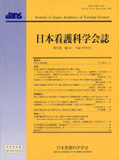Japanese
English
- 販売していません
- Abstract 文献概要
- 参考文献 Reference
- サイト内被引用 Cited by
要旨
本研究の目的は, 脳障害のため意識や反応がなく, 人工呼吸器に生命を委ねている子どもに対して, 看護師がどのように子どもを理解し関わっているのかを明らかにすることである. Leininger の民族看護学の研究方法に基づき, 7名の主要情報提供者と14名の一般情報提供者に対する参加観察と面接を行った. 分析の結果, 5つのテーマと1つの大テーマ「看護師は, アラームやわずかな変化を'子どもの声'として意味づけをしていくことで, 生かされているのではなく生きている子どもとして, その子らしさを見出していく」が抽出された. アラームやわずかな変化から読み取ることと, それらに感情や意思を結びつけていくことにより, 子どもの個性を創り上げていることが明らかになった. このことから, 子どものわずかな変化と感情や意思とを結びつけて捉えた内容を共有し深めていく方法の工夫や, プロセスを言語化していく必要性が示唆された.
Abstract
The aim of this study was to identify the optimum care for seriously handicapped children who were unable to breathe for themselves and did not respond to anything. This study used an ethnonursing research method, under which seven nurses were chosen as key informants and fourteen were chosen as general informants. Dates were recorded from interviews and from participating in observation. As the results of the analysis, five sub themes and one main theme were extracted. The main theme was that the nurses regarded any minute change in the children and the sound of the monitor's alarm as'the child's voice,'and built up each child's personality not as'a child that once lived'but as'a living child.'
As the result, caring for totally nonresponsive seriously handicapped children on respiratory support had two elements that were based on observations of minute changes in the children and the monitor alarm, bringing together emotion and intention, which is how the nurses build up these children's personality.
The findings suggest the importance to nurses working with such children of sharing information on their patients and of expressing their nursing experience in words.
Copyright © 2005, Japan Academy of Nursing Science. All rights reserved.


